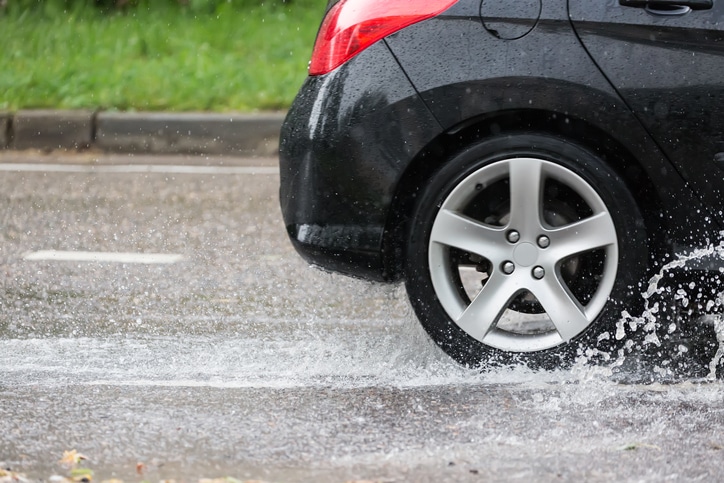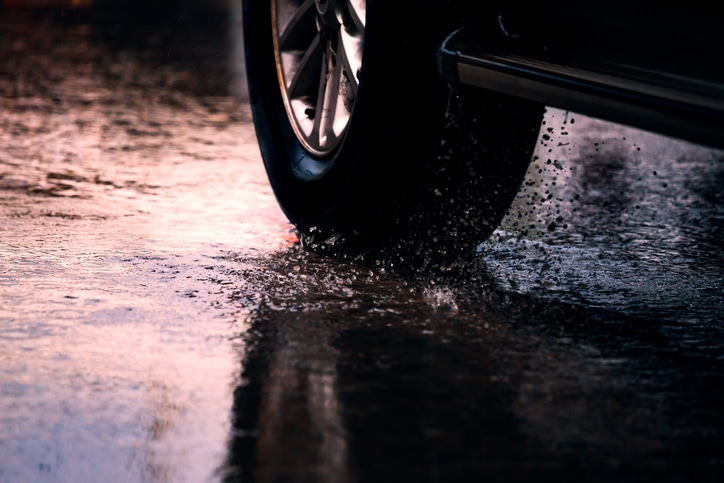Aquaplaning is one of the biggest hazards of wet weather driving. It happens when water gets between your tyres and the road, and can easily lead to loss of control, skids or an accident.
Aquaplaning can happen in any car, but there are things you can do to prevent it. In this guide, we look at the dangers of aquaplaning, how to control your car when it’s aquaplaning, and the things you can do to reduce the risk of it happening in the first place.
Use the links below to jump ahead or read on for our complete aquaplaning guide:
- What causes aquaplaning?
- How can I tell if my car is aquaplaning?
- How do I control my car while aquaplaning?
- Tips on how to prevent aquaplaning
What causes aquaplaning?

Normally, aquaplaning only lasts for a few seconds and the wheels will gain traction again before you’ve really even had time to react. But, if you drive through a puddle at speed or roads are very wet, all four wheels might lose traction for a few hundred metres – and that can be a pretty frightening experience.
The risk of aquaplaning is impacted by two factors: speed and wheel condition. Speed has the biggest effect because the faster you’re travelling the less water displacement the tyres can handle. But the condition of the tyres can have an impact too, which is why it’s important to check your tyre tread depth regularly in winter.
How can I tell if my car is aquaplaning?
Below, we list some of the signs that your car is aquaplaning so you know what to look out for and how to take action:
- High revs – the engine will rev loudly as if you’ve put your foot on the clutch while still pressing the accelerator
- Inaccurate speed – the speedo will give you an inaccurate reading because the wheels are spinning
- Light steering – without any grip on the road, the steering will feel light, so go easy and use really small movements
- Fishtailing or skidding – the backend might feel jittery or you might skid altogether
- No traction from a standing start – if you accelerate hard in standing water, the wheels will spin, and you’ll get nowhere fast. This is something to remember when pulling out of junctions and roundabouts.
When your car regains traction, you might feel a sudden jerk as the tyres grip and send you in a certain direction. Hold the steering wheel firmly to control the car.
How do I control my car while aquaplaning?
Aquaplaning is never fun and can cause some nasty accidents. But, there are ways to adjust your driving style when your car starts to aquaplane which will reduce the likelihood of your car spinning out. Here’s how to regain control of your car when it’s aquaplaning:
- Take your foot off the accelerator gently – your instant reaction may be to hit the brakes, but this will only make it more likely for you to skid. Gently ease your foot off to avoid any sudden change in speed or direction.
- Keep the steering wheel straight – gripping the steering wheel firmly with both hands, keep it straight and avoid turning. With no traction on the front wheels, any sudden movement on the wheel could send the car into a spin.
- Slow down to a safer speed – when the wheels regain traction, keep your speed down to stop the car from aquaplaning again and use steady movements, particularly when turning and braking.
Tips on how to prevent aquaplaning
The risk of aquaplaning can make driving in wet conditions stressful, but there are lots of things you can do to stop it from happening or reduce the risk.
Here are our tips on how to prevent your car from aquaplaning.
- Drive smoothly and watch your speed
How you drive in wet weather is the key to stopping your car from aquaplaning. Aquaplaning happens when a car is driving too fast for the conditions, so if you slow down by as little as 5mph on wet roads, you’ll massively reduce the likelihood of aquaplaning.
As well as slowing down, you should also try to drive smoothly. Don’t accelerate or brake hard; instead, read the road ahead to keep the wheels rolling at a safe, steady pace. You should also make turns more slowly and smoothly than you otherwise would, this stops the car from skidding around corners.
- Check your tyres every two weeks
In the wet winter months, you should get into the habit of checking your tyres every fortnight, both for pressure and tread depth. The condition of tyres can make all the difference in winter, and a healthy tread depth will go a long way in preventing aquaplaning.
If your tyres are looking low on tread now, we’d recommend getting a new set before winter really gets into full swing, or at least rotating the front ones with the back. Tyre tread helps the wheel to displace water, so plenty of rubber is what you need to stop aquaplaning.
- Follow ‘tracks’ in the road
On really wet days, you’ll notice ‘tracks’ on the road left by the car in front. These tyre marks show areas where the water has been displaced off to the side, so you can reduce the likelihood of aquaplaning by driving in them as they’ll be drier than other parts of the carriageway.
- Turn off cruise control in wet weather
If you often drive with cruise control on, we’d recommend switching it off in wet weather. It’s important to be in control of the accelerator pedal when there’s a risk of aquaplaning, as that’s what you’ll use to gradually slow down the car.
- Don’t drive through puddles
This is the simplest tip! Sometimes you can’t avoid puddles, but if it’s safe then drive around them. Standing water is the cause of aquaplaning, and puddles can easily trigger a loss of traction.
Prestone believes in safe driving in all conditions, and our performance car maintenance products are tested in extremes, so you know they’ll work in your car. For more information, visit our homepage today.


